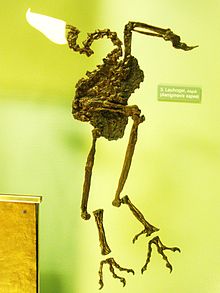Ameghinornithidae
|
Strigogyps Temporal range: Middle Eocene to Early Oligocene |
|
|---|---|
 |
|
| Strigogyps sapea fossil. | |
| Scientific classification | |
| Kingdom: | Animalia |
| Phylum: | Chordata |
| Class: | Aves |
| Order: | Cariamiformes |
| Family: | Ameghinornithidae |
| Genus: |
Strigogyps Gaillard, 1908 |
| Species | |
|
S. dubius Gaillard, 1908 (type) |
|
| Synonyms | |
|
Aenigmavis Peters, 1987 |
|
S. dubius Gaillard, 1908 (type)
S. robustus (Lambrecht, 1935) (originally Eocathartes/Geiseloceros robustus)
S. sapea (Peters, 1987) (originally Aenigmavis sapea)
Aenigmavis Peters, 1987
Ameghinornis Mourer-Chauviré, 1981
Eocathartes Lambrecht, 1935
Geiseloceros Lambrecht, 1935
Strigogyps is an extinct genus of prehistoric bird from the Middle Eocene to Early Oligocene of France and Germany. It was probably around the size of a large chicken or a guan, weighing not quite 1 kilogram (2.2 lb). Apparently, as indicated by the ratio of lengths of wing to leg bones, S. sapea was flightless. Its legs were not adapted to running, so it seems to have had a walking lifestyle similar to trumpeters. Unlike other Cariamiformes, which seem to have been pretty consistently carnivorous, Strigogyps specimens suggest a more herbivorous diet.
The type species of Strigogyps is S. dubius, which was described by Gaillard in 1908. It was initially placed in the owl order Strigiformes and considered to be a sophiornithid. S. dubius is based on a single tibiotarsus from the Late Eocene to Early Oligocene Quercy phosphorites of France. This tibiotarsus was destroyed in World War II during the bombing of Munich, but casts remain. In 1939, Gaillard described a second species of Strigogyps, S. minor, based on a humerus, two coracoids, and two carpometacarpi, also from Quercy. In 1981, Mourer-Chauviré redescribed S. minor as Ameghinornis minor, the only member of the new phorusrhacid subfamily, Ameghinornithinae.Ameghinornis was later placed in its own family, Ameghinornithidae. In 1987, Peters named another monospecific genus of ameghinornithid, Aenigmavis sapea, based on a nearly complete skeleton from the Middle Eocene Messel pit of Germany. Mayr (2005) found Aenigmavis to be a species of Strigogyps, S. sapea, and found Ameghinornis to be synonymous with S. dubius, as they both came from Quercy, and are almost identical except for coracoids and carpometacarpi of Ameghinornis, which Mayr found to be unlike other ameghinornithids, and probably from an idiornithid.
...
Wikipedia
